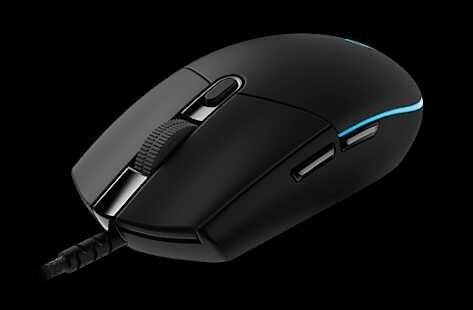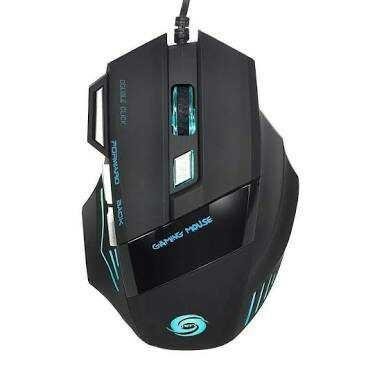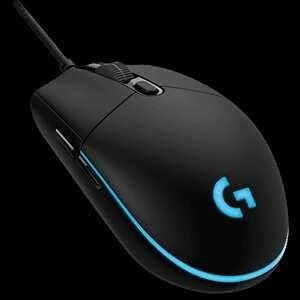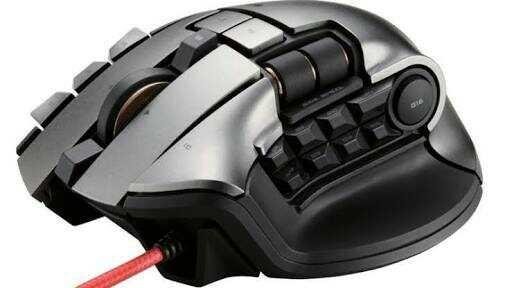Computer Mouse
Computer Mouse:

Photo source
A PC mouse is a hand-held pointing gadget that recognizes two-dimensional movement with respect to a surface. This movement is commonly converted into the movement of a pointer on a show, which permits a smooth control of the graphical UI. The principal open exhibit of a mouse controlling a PC framework was in 1968. Initially wired to a PC, present day mice are regularly cordless, depending on short-run radio correspondence with the associated framework. Mice initially utilized a ball moving on a surface to identify movement, yet current mice regularly have optical sensors that have no moving parts. Notwithstanding moving a cursor, PC mice have at least one catches to permit activities, for example, determination of a menu thing on a show. Mice frequently likewise highlight different components, for example, contact surfaces and "wheels", which empower extra control and dimensional information.
Naming:

Photo source
The soonest referred to distribution of the term mouse as alluding to a PC pointing gadget is in Bill English's July 1965 production, "PC Aided Display Control".
The plural for the little rat is dependably "mice" in present day use. The plural of a PC mouse is "mouses" and "mice" as indicated by most word references, however "mice" being more typical. The primary recorded plural use is "mice"; the online Oxford Dictionaries refers to a 1984 utilize, and prior utilizations incorporate J. C. R. Licklider's "The Computer as a Communication Device" of 1968.[5] The term PC mouses might be utilized casually at times. In spite of the fact that, the plural of mouse (little rat) is mice, the two words have experienced a separation through utilization.
History:

Photo source
The trackball, a related pointing gadget, was designed in 1946 by Ralph Benjamin as a major aspect of a post-World War II-period fire-control radar plotting framework called Comprehensive Display System (CDS). Benjamin was then working for the British Royal Navy Scientific Service. Benjamin's venture utilized simple PCs to figure the future position of target airplane in view of a few beginning info focuses gave by a client a joystick. Benjamin felt that a more exquisite information gadget was required and created what they called a "roller ball" for this reason.
The gadget was licensed in 1947, however just a model utilizing a metal ball moving on two elastic covered wheels was ever constructed, and the gadget was kept as a military mystery.
Another early trackball was worked by British electrical architect Kenyon Taylor as a team with Tom Cranston and Fred Longstaff. Taylor was a piece of the first Ferranti Canada, chipping away at the Royal Canadian Navy's DATAR (Digital Automated Tracking and Resolving) framework in 1952.
DATAR was comparable in idea to Benjamin's show. The trackball utilized four plates to get movement, two each for the X and Y headings. A few rollers gave mechanical help. At the point when the ball was rolled, the pickup circles spun and contacts on their external edge reached wires, creating beats of yield with every development of the ball. By checking the beats, the physical development of the ball could be resolved. A computerized PC figured the tracks and sent the subsequent information to different ships in a team utilizing beat code regulation radio signs. This trackball utilized a standard Canadian five-stick knocking down some pins ball. It was not licensed, since it was a mystery military undertaking.
Douglas Engelbart of the Stanford Research Institute (now SRI International) has been credited in distributed books by Thierry Bardini, Paul Ceruzzi, Howard Rheingold, and a few others as the designer of the PC mouse. Engelbart was likewise perceived accordingly in different tribute titles after his passing in July 2013.
By 1963, Engelbart had officially settled an exploration lab at SRI, the Augmentation Research Center (ARC), to seek after his target of creating both equipment and programming PC innovation to "enlarge" human knowledge. That November, while going to a gathering on PC designs in Reno, Nevada, Engelbart started to contemplate how to adjust the basic standards of the planimeter to X-Y arrange input. On November 14, 1963, he initially recorded his contemplations in his own journal about something he at first called a "bug," which in a "3-point" shape could have a "slanted edge and 2 orthogonal wheels." He composed that the "bug" would be "simpler" and "more characteristic" to utilize, and not at all like a stylus, it would remain still when given up, which implied it would be "much better for coordination with the console."
In 1964, Bill English joined ARC, where he helped Engelbart construct the main mouse model. They dedicated the gadget the mouse as early models had a string appended to the back piece of the gadget which resembled a tail, and thusly took after the basic mouse. As noted over, this "mouse" was first specified in print in a July 1965 report, on which English was the lead creator. On 9 December 1968, Engelbart freely exhibited the mouse at what might come to be known as The Mother of All Demos. Engelbart never got any sovereignties for it, as his manager SRI held the patent, which terminated before the mouse turned out to be generally utilized as a part of PCs. In any occasion, the development of the mouse was only a little piece of Engelbart's substantially bigger venture of expanding human judgment.
A few other test pointing-gadgets produced for Engelbart's oN-Line System (NLS) misused diverse body developments – for instance, head-mounted gadgets connected to the button or nose – at the end of the day the mouse won out on account of its speed and comfort. The principal mouse, a massive gadget (imagined) utilized two potentiometers opposite to each other and associated with wheels: the pivot of each wheel converted into movement along one hub. At the season of the "Mother of All Demos", Engelbart's gathering had been utilizing their second era, 3-catch mouse for about a year.
On October 2, 1968, a mouse gadget named Rollkugel (German for "moving ball") was depicted as a discretionary gadget for its SIG-100 terminal was created by the German organization Telefunken. As the name recommends and not at all like Engelbart's mouse, the Telefunken demonstrate as of now let loose. It depended on a before trackball-like gadget (additionally named Rollkugel) that was inserted into radar flight control work areas. This trackball had been produced by a group drove by Rainer Mallebrein at Telefunken Konstanz for the German Bundesanstalt für Flugsicherung as a component of their TR 86 process PC framework with its SIG 100-86 vector illustrations terminal.
At the point when the improvement for the Telefunken primary casing TR 440 (de) started in 1965, Mallebrein and his group thought of "turning around" the current Rollkugel into a moveable mouse-like gadget, so clients did not need to be wasted time with mounting openings for the prior trackball gadget. Together with light pens and trackballs, it was offered as a discretionary info gadget for their framework since 1968. Some Rollkugel mouses introduced at the Leibniz-Rechenzentrum in Munich in 1972 are all around protected in a museum.[29][31] Telefunken considered the creation excessively insignificant, making it impossible to apply for a patent on it.
The Xerox Alto was one of the main PCs intended for singular use in 1973 and is viewed as the primary present day PC to use a mouse.[32] Inspired by PARC's Alto, the Lilith, a PC which had been created by a group around Niklaus Wirth at ETH Zürich in the vicinity of 1978 and 1980, gave a mouse also. The third showcased rendition of an incorporated mouse sent as a piece of a PC and proposed for PC route accompanied the Xerox 8010 Star in 1981.
By 1982, the Xerox 8010 was most likely the best-known PC with a mouse. The Sun-1 likewise accompanied a mouse, and the inevitable Apple Lisa was supposed to utilize one, however the fringe stayed cloud; Jack Hawley of The Mouse House detailed that one purchaser for an expansive association accepted at first that his organization sold lab mice. Hawley, who fabricated mice for Xerox, expressed that "Basically, I have the market all to myself at the present time"; a Hawley mouse cost $415.[33] That year Microsoft settled on the choice to influence the MS-DOS to program Microsoft Word mouse-perfect, and built up the primary PC-good mouse. Microsoft's mouse sent in 1983, therefore starting the Microsoft Hardware division of the company.[34]However, the mouse remained generally darken until the presence of the Macintosh 128K (which incorporated a refreshed adaptation of the Lisa Mouse) in 1984,[35] and of the Amiga 1000 and the Atari ST in 1985.
Operation:

Photo source
A mouse commonly controls the movement of a pointer in two measurements in a graphical UI (GUI). The mouse turns developments of the hand in reverse and forward, left and directly into proportionate electronic signs that thus are utilized to move the pointer.
The relative developments of the mouse at first glance are connected to the situation of the pointer on the screen, which flags the point where moves of the client make put, so hand developments are imitated by the pointer.[36] Clicking or floating (ceasing development while the cursor is inside the limits of a region) can choose records, projects or activities from a rundown of names, or (in graphical interfaces) through little pictures called "symbols" and different components. For instance, a content record may be spoken to by a photo of a paper note pad and clicking while the cursor floats this symbol may cause a word processing project to open the document in a window.
Distinctive methods for working the mouse make particular things occur in the GUI:[36]
Snap: squeezing and discharging a catch.
(left) Single-tick: tapping the primary catch.
(left) Double-click: tapping the catch two times one after another considers an unexpected signal in comparison to two separate single snaps.
(left) Triple-click: tapping the catch three times with hardly a pause in between considers an unexpected motion in comparison to three separate single snaps. Triple snaps are far less basic in traditi.